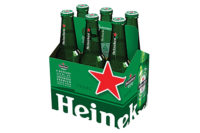
Carrying On The Tradition
BY SARAH THEODORE
Beam Global merges the new with the old at its
Clermont, Ky., distillery
Beam Global Spirits &
Wine’s Clermont, Ky., distillery is the “heart and soul of Jim
Beam,” says Vice President of Americas Operations Jeff Conder. The
facility is home to the company’s flagship Jim Beam bourbon brand,
and like the rest of Beam Global, has spent the
past year integrating new brands into its operation.
In total, Beam’s Americas operations include
seven plants — four in Kentucky, one in Ohio and distilleries in
Canada and Mexico — and co-packing operations in South America.
“All of the plants share a part in helping us integrate the new
brands and the volumes,” Conder says. “We are fortunate to have
assets that can be expanded to accommodate the extra production, so a
number of facilities throughout the United States will be growing in the
coming year.”
The addition of the new brands may have created a
flurry of new activity, but they did little to alter the historic
atmosphere of the facility. Still family-operated, the Clermont distillery
produces bourbon following the same recipe created by Jacob Beam in 1795.
The facility that stands today was rebuilt in 1934 by James B. Beam —
namesake to the Jim Beam brand — following the repeal of Prohibition.
As the story goes, Beam was so serious about getting
the business going again, “He built, from the ground up, a distillery
and had it operating in 120 days,” says Jerry Dalton, master
distiller and senior director of quality control and environmental health
and safety. “It’s doubly amazing when you consider that he was
a man that was more than 70 years old at the time. Since then, it’s
continued to be a family business.”
Dalton is the first Jim Beam master distiller who is
not related to the family, but Fred Noe, great grandson of Jim Beam, serves
as Bourbon Ambassador and master distiller in training. Noe says he entered
the family business in the facility’s bottling operations and learned
several parts of the business before moving into his current role in brand
promotion. He spends much of his time traveling the country, meeting with
customers and conducting whiskey tastings, and says the family connection
resonates with consumers.
“I think bourbon is a very traditional product,
with recipes handed down from generation to generation,” he says.
“Having a person who is actually kin to the Beam founder, I think,
makes it more legitimate.”
One of Noe’s responsibilities these days
includes choosing the small-batch bourbon that carries his father’s
name. Booker Noe served as master distiller from 1960 until 1992, and
master distiller emeritus from 1992 until his death in 2004. Booker’s
bourbon was the first of Beam’s small-batch collection, and is a
fitting tribute to his influence on the industry, Dalton says. Other
members in the Small Batch bourbon collection include Knob Creek, Basil
Hayden and Bakers.
“Booker was the fellow that about
single-handedly caused a resurgence in bourbon,” he says.
“Bourbon had been declining in popularity from the ‘50s on, and
Booker took a great interest in what we did and took his family heritage
very seriously. He came up with the first small-batch bourbon.”
“Booker gets credit for pioneering the concept
of ultra-premium bourbon with the small-batch collection,” says Noe.
“In fact, you could say he is responsible for the emergence of a new
type of bourbon drinker — the bourbon connoisseur. This is where growth is taking place in the category, and
it’s not unusual to see year-on-year double-digit increases across
the small-batch collection.”
Booker’s bourbon is an uncut, unfiltered,
straight-from-the-barrel product that was selected by Noe himself for each
bottling. Today, that choice is made by Fred Noe, who says he looks for the
characteristics his father liked, but bases the decision on his own tastes.
“I just look at what I like because that’s what he always
said… ‘If you like it, everyone else will, too,’”
Noe says.
Under the Jim Beam brand umbrella, there are three
additional small-batch bourbons as well as the flagship Jim Beam product,
known as Jim Beam White, and Jim Beam Black. According to Dalton, the
products carry the signature characteristics of the facility. “With a
bourbon facility, you can consider the product almost a fingerprint of the
distillery,” he says.
The distillery not only uses the original recipe, but
the same strain of yeast isolated by Jim Beam. Dalton says one of his most
important jobs is balancing tradition with new technology. “Beam uses
almost any cutting-edge technology — computers, programmable logic
controls, automation — we use all of those, but we use them very
advisably,” he says. “It’s my job, and I take this deadly
serious, to protect the 200-year-old Beam process. Somebody might have a
lovely idea, but if it has any potential to damage the Beam process, I
simply won’t allow it.”
The process begins with grain, including corn grown in
Kentucky and Indiana, barley and rye. Combined, they make up what is
referred to as the mash bill. The gain is milled and mixed with limestone
water. “One of the reasons bourbon distilling grew up here is the
limestone water supply in Kentucky, so we take advantage of the natural raw
materials around us,” Dalton says.
In addition to water, the grains are combined with
some of the mash from a previous batch, which defines the sour mash
process. Sour mashing helps create consistency from one batch to another
and maintain the flavor characteristics. In a two-step process, the first
mash is heated to make the starch from the corn available, and then barley
malt is added to help convert the starches to sugar. The sugars are
required for the fermentation process, during which yeast is added to
convert the sugar to alcohol. The process takes three to five days, and the
resulting liquid is called distiller’s beer. The distiller’s
beer is between 9 and 10 percent alcohol and contains carbon dioxide, which
is a natural byproduct of fermentation.
The distiller’s beer moves to the two-step
distillation process, first entering the beer still where the alcohol is
heated to create a vapor. The vapor is captured and condensed to create a
liquid called low wine. Low wine is about 125 proof. The low wine moves to
a second still where it is heated again, converted to vapor and condensed a
second time. The process, called doubling, results in high wine or
“white dog.” High wine is clear in color, about 135 proof, and
by regulation can be no more than 160 proof.
“Then you get to the part where you’ve got
to have patience,” Dalton says. The white dog is filled into new
charred oak barrels for aging. Barrels can only be used once to produce
bourbon, but Beam reuses the barrels for other products such as tequila or
Canadian whisky, and the majority of the used barrels are dismantled, sent
to Scotland and re-coopered for Scotch whisky.
Dalton says quality control measures at the facility
extend all the way to the two cooperages that produce the barrels.
“We know a lot about barrels and how they affect whiskey
losses,” he says. “We’ve partnered with our cooperages so
they have process controls in place and we’ve told them what we
need.”
Aging in oak barrels imparts all of the color to the
bourbon and many of its characteristics, although Dalton points out that it
is a misconception that aging provides all of the flavor.
“The white dog, the distillate, does have
flavor, even before it goes into the barrel,” he says. “How you
distill the whiskey is extremely important in the making of the final
product, and by variations in the distillation, we can cause subtle
variations in the ultimate taste profile and nose profile of the
product.”
Depending on variety, the bourbon is aged anywhere
from four to nine years in rackhouses. Beam has a storage capacity of 1.2
million bourbon barrels, and the company is in the process of constructing
more rackhouses in anticipation of future needs.
Barrels weigh 500 pounds going into the rackhouse, and
during four years of aging lose 21 to 22 percent of their content through
evaporation. No worries though, the lost volume, known as the angel’s
share, only helps to create the character of the whiskey.
Bourbon ages differently depending on where barrels
are located in the rackhouse, with higher barrels losing more water to
evaporation, and lower barrels retaining more. When the aging process is
complete, the higher-proof bourbon from the top of the rackhouse is
commingled with the lower-proof bourbon from the bottom to create the right
profile for the finished product. After dumping and commingling, the
bourbon is filtered for clarity, water is added to reduce the product to
the correct proof, and it is filtered again.
“One thing that is extremely important in the
regulations that we have to abide by is that you cannot add any flavor or
color to bourbon whiskey,” Dalton says. “What you see in the
bottle came out of the natural fermentation, distillation and aging
process; there is no color or flavor added. If you do either of those
things, you remove it from the bourbon category.”
The Clermont facility has nine bottling lines,
including several high-speed lines, one of which runs 700-ml. to 750-ml.
bottles at 350 bottles per minute, one that runs 200-ml. and 375-ml.
flask-shaped bottles at 450 bottles per minute, and a
“miniature” line that runs 50-ml. bottles at 310 bottles per
minute.
The plant also features several multipurpose lines
that run about 180 bottles per minute and can be used for holiday packages,
products that need to be placed in cartons, and bottles that require
hang-tags or other promotional add-ons.
The Jim Beam facility is the company’s largest
U.S. export facility, with about 35 percent of the product being exported,
according to Conder. The company’s new, more global presence, has
meant upgrading, or at least documenting, many of its procedures. The
distillery has nearly completed its HACCP (Hazard Analysis Critical Control
Points) procedures and is beginning the process of ISO 9001 certification.
“We’re adopting a more global strategy of
what our manufacturing sites should look like,” Conder says.
“The plants have continuous improvement efforts, which have really
helped to set the foundation for moving toward some of the more European
standards like ISO.”
During high season, the Clermont facility employs
about 420 people, and Conder estimates the company has about 800 employees
total in Kentucky. Both Dalton and Conder say it is difficult to overstate
the importance of the Jim Beam brand and the distilleries to the local
area. “This is a wildly important part of the economy,” Dalton
says. “The best known businessman in Kentucky is Jim Beam, and the Beam distillery and operation has been a driver in the local
economy since before Prohibition.”
With the number of new products Beam Global is
bringing into its production network, it is likely it will be important to
the area for a long time to come.
Bourbon rules
ourbon is considered a product of unique national
origin, thanks to a 1964 congressional mandate. To be considered bourbon,
whiskey must comply with several specifications.
Bourbon must be made with a
minimum of 51 percent corn.
It must be aged in a new charred oak container.
It must be distilled at 160 proof or lower.
It cannot be barreled at more than 125 proof.
It cannot be bottled at lower than 80 proof.
No colors or flavors can be added.
It must be aged in a new charred oak container.
It must be distilled at 160 proof or lower.
It cannot be barreled at more than 125 proof.
It cannot be bottled at lower than 80 proof.
No colors or flavors can be added.





